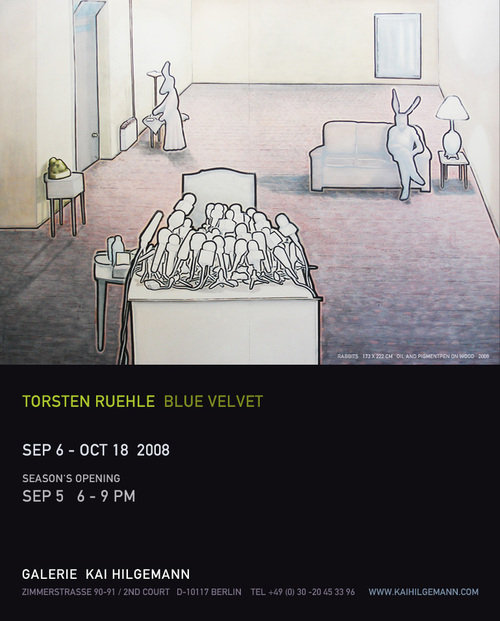Torsten Ruehle
dal 4/9/2008 al 17/10/2008
Segnalato da
4/9/2008
Torsten Ruehle
Gallery Kai Hilgemann, Berlin
Blue Velvet

Torsten Ruehle
* Born in 1975 in Dresden, Germany; lives and works in Berlin
* 2003 2005 Studied with Professor Arno Rink at the Hochschule für Grafik
und Buchkunst (³Academy for graphics and book art²) in Leipzig as well as
with Professor Hanns Schimansky at the Kunsthochschule Weißensee (³Art
Academy²) in Berlin
stereochrom
Emil Otto Nardorff
Torsten Ruehle is busy changing the world: He takes high-energy, film-like
pictures (such as those of David Lynch, Alejandro Gonzalez Inarritu, Aki
Kaurismäki and Roy Andersson) and photographs of classic interiors (such as
those of Mies van der Rohe, Charles & Ray Eames and Richard Neutra) and
makes light, surreal arrangements of the atmospheric pictures by
reorienting, modifying and adding to them.
His use of this method leads to a plethora of gadgets, equipment and
technical apparatuses interacting with scenery: The dimensions, temperature,
swells and colors of swimming pools are altered while clouds dimly tug on
ceilings and houses begin to hover; bottles and ice cream bowls fly through
space and whimsical cows are draped on a field of carpet while carousel
ponies and oranges roll about.
He brings into the tangible world of pictures a vivid collage piecing
together both motives from the daily, shoreless flood of pictures that
strands itself within the mind as well as facets of real life, things
observable and able to be photographed. He makes the present appear to be a
montage of modified reality sometimes Elysian, sometimes markedly cryptic.
The pictures are created with the use of a very individual technique:
massive, static black lines graphically set the form, which is primarily
complemented by and broken up with scumbling oil paint; the rhythm of the
lines loses itself emotionally to the melodies of the colors colors which,
in a singular phenomenon, become more and more and more fascinating the
longer the picture is viewed. The details, patterns, radiating lines, and
bolting arrows often drawn into the pictures with colored pencil, which
effortlessly create visual tension, are only apparent upon a closer look.
Everything seems peaceful and demure, like a still life. The occasional
protagonist appears to be absent and withdrawn. Though the scenic pictures
appear intimate and familiar, at the same time it is nearly impossible to
pull away from the almost embarrassing strangeness they emanate. The
pictures seem to float in the air, as if something will happen at any moment
to release the feeling of tension so inherent within them. And although
there is nothing of a classical feeling about the pictures, a sort of
film-like impression arises: Time seems to disappear as you look at them.
Opening sept. 5, 2008
Gallery Kai Hilgemann
Zimmerstrasse 90/91, 2.Square - Berlin
Hours: Tue-Sat 11-6pm, Saturday 6.9. 11-6 pm, Sunday 7.9. 11-6 pm
Free admission



